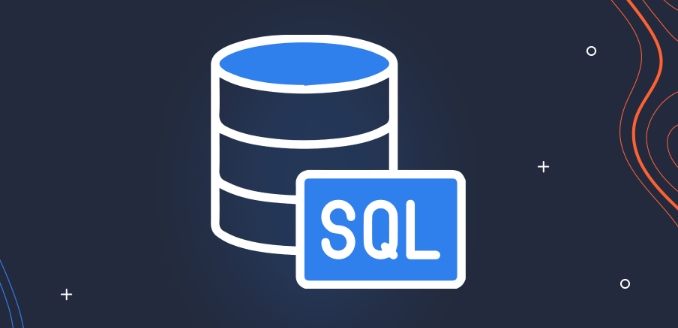Implementing SQL Triggers for Automated Data Management
Jul 24, 2025 am 01:46 AMSQL triggers are special stored procedures that are automatically executed when database operations are performed. It can be automatically run when an INSERT, UPDATE, or DELETE event occurs to simplify the process and improve data consistency. For example, the inventory table can be automatically updated when inserting a record into the order table. Common triggering events include INSERT (insert new rows), UPDATE (update existing rows), and DELETE (delete rows), and are divided into BEFORE (before operation) and AFTER (after operation) triggers according to the execution time. To create a basic trigger, you need to specify the name, trigger time, event type and execution actions, such as using the CREATE TRIGGER statement. Its typical application scenarios include data auditing, automatic update fields, cascading operations and data consistency checks. When using it, you should pay attention to performance impact, debugging difficulty, logic complexity and portability issues, and it is recommended to keep the logic concise, sufficient testing and documented management. Rational use of triggers can significantly improve database management efficiency.

In database management, automating certain operations can greatly improve efficiency and data consistency. SQL Trigger is a mechanism to implement this type of automation. It can automatically execute predefined SQL statements when specified database operations (such as INSERT, UPDATE, DELETE), thereby helping us simplify the process and reduce human errors.

What are SQL triggers?
A trigger is essentially a special stored procedure that is not called explicitly, but is automatically triggered when some kind of data operation occurs on a specific table or view. For example, you can automatically update the quantity of the inventory table when a new record is inserted.
Common triggering events include:

-
INSERT: Triggered when inserting a new line -
UPDATE: Triggered when an existing row is updated -
DELETE: Triggered when deleting a row
According to the triggering timing, it can also be divided into BEFORE trigger (execute before operation) and AFTER trigger (execute after operation).
How to create a basic trigger?
The basic syntax for creating triggers is as follows (taking MySQL as an example):

CREATE TRIGGER trigger_name
BEFORE/AFTER INSERT/UPDATE/DELETE ON table_name
FOR EACH ROW
BEGIN
-- SQL statements
END; For example, suppose you have an order table orders and an inventory table inventory . Whenever a new order is inserted, you want to automatically reduce the inventory quantity of the corresponding product:
CREATE TRIGGER reduce_inventory_after_order
AFTER INSERT ON orders
FOR EACH ROW
BEGIN
UPDATE inventory
SET stock = stock - NEW.quantity
WHERE product_id = NEW.product_id;
END; Here NEW is a special keyword that indicates the newly inserted record.
Common usage scenarios for triggers
- Data audit : record data change logs, such as recording who modified a record when.
- Automatic update field : For example, automatically set the
last_modifiedtimestamp when updating a record. - Cascading operation : Automatically update or delete relevant data in the slave table when the main table data changes.
- Data consistency check : Verify that data complies with business rules before inserting or updating.
For example, you want to automatically record the update time every time you update user information:
CREATE TRIGGER update_user_last_modified
BEFORE UPDATE ON users
FOR EACH ROW
BEGIN
SET NEW.last_modified = NOW();
END;Issues to note when using triggers
Although triggers are powerful, there are also some potential problems that need to be paid attention to when using them:
- Performance Impact : SQL executed by triggers increases the burden on the database, especially when the big data tables are frequently operated.
- Debugging difficulty : Triggers are executed implicitly and are not easy to troubleshoot when errors occur.
- Logical complexity : Multiple triggers may affect each other, resulting in logical confusion.
- Poor portability : Different database systems have different syntax for triggers, and may require rewriting during migration.
suggestion:
- Keep trigger logic concise and avoid complex nesting
- Go online after the development environment is fully tested
- Documenting the role and logic of each trigger
Basically that's it. Triggers are a powerful tool for database automation, but when used well, you need to understand its mechanisms and limitations. Rational use can make your data management more efficient.
The above is the detailed content of Implementing SQL Triggers for Automated Data Management. For more information, please follow other related articles on the PHP Chinese website!

Hot AI Tools

Undress AI Tool
Undress images for free

Undresser.AI Undress
AI-powered app for creating realistic nude photos

AI Clothes Remover
Online AI tool for removing clothes from photos.

Clothoff.io
AI clothes remover

Video Face Swap
Swap faces in any video effortlessly with our completely free AI face swap tool!

Hot Article

Hot Tools

Notepad++7.3.1
Easy-to-use and free code editor

SublimeText3 Chinese version
Chinese version, very easy to use

Zend Studio 13.0.1
Powerful PHP integrated development environment

Dreamweaver CS6
Visual web development tools

SublimeText3 Mac version
God-level code editing software (SublimeText3)
 How to find columns with a specific name in a SQL database?
Jul 07, 2025 am 02:08 AM
How to find columns with a specific name in a SQL database?
Jul 07, 2025 am 02:08 AM
To find columns with specific names in SQL databases, it can be achieved through system information schema or the database comes with its own metadata table. 1. Use INFORMATION_SCHEMA.COLUMNS query is suitable for most SQL databases, such as MySQL, PostgreSQL and SQLServer, and matches through SELECTTABLE_NAME, COLUMN_NAME and combined with WHERECOLUMN_NAMELIKE or =; 2. Specific databases can query system tables or views, such as SQLServer uses sys.columns to combine sys.tables for JOIN query, PostgreSQL can be used through inf
 How to backup and restore a SQL database
Jul 06, 2025 am 01:04 AM
How to backup and restore a SQL database
Jul 06, 2025 am 01:04 AM
Backing up and restoring SQL databases is a key operation to prevent data loss and system failure. 1. Use SSMS to visually back up the database, select complete and differential backup types and set a secure path; 2. Use T-SQL commands to achieve flexible backups, supporting automation and remote execution; 3. Recovering the database can be completed through SSMS or RESTOREDATABASE commands, and use WITHREPLACE and SINGLE_USER modes if necessary; 4. Pay attention to permission configuration, path access, avoid overwriting the production environment and verifying backup integrity. Mastering these methods can effectively ensure data security and business continuity.
 When to use SQL subqueries versus joins for data retrieval.
Jul 14, 2025 am 02:29 AM
When to use SQL subqueries versus joins for data retrieval.
Jul 14, 2025 am 02:29 AM
Whether to use subqueries or connections depends on the specific scenario. 1. When it is necessary to filter data in advance, subqueries are more effective, such as finding today's order customers; 2. When merging large-scale data sets, the connection efficiency is higher, such as obtaining customers and their recent orders; 3. When writing highly readable logic, the subqueries structure is clearer, such as finding hot-selling products; 4. When performing updates or deleting operations that depend on related data, subqueries are the preferred solution, such as deleting users that have not been logged in for a long time.
 Comparing Different SQL Dialects (e.g., MySQL, PostgreSQL, SQL Server)
Jul 07, 2025 am 02:02 AM
Comparing Different SQL Dialects (e.g., MySQL, PostgreSQL, SQL Server)
Jul 07, 2025 am 02:02 AM
SQLdialectsdifferinsyntaxandfunctionality.1.StringconcatenationusesCONCAT()inMySQL,||orCONCAT()inPostgreSQL,and inSQLServer.2.NULLhandlingemploysIFNULL()inMySQL,ISNULL()inSQLServer,andCOALESCE()commonacrossall.3.Datefunctionsvary:NOW(),DATE_FORMAT()i
 How to find the second highest salary in SQL
Jul 14, 2025 am 02:06 AM
How to find the second highest salary in SQL
Jul 14, 2025 am 02:06 AM
There are three core methods to find the second highest salary: 1. Use LIMIT and OFFSET to skip the maximum salary and get the maximum, which is suitable for small systems; 2. Exclude the maximum value through subqueries and then find MAX, which is highly compatible and suitable for complex queries; 3. Use DENSE_RANK or ROW_NUMBER window function to process parallel rankings, which is highly scalable. In addition, it is necessary to combine IFNULL or COALESCE to deal with the absence of a second-highest salary.
 What is the difference between SQL and NoSQL
Jul 08, 2025 am 01:52 AM
What is the difference between SQL and NoSQL
Jul 08, 2025 am 01:52 AM
The core difference between SQL and NoSQL databases is data structure, scaling method and consistency model. 1. In terms of data structure, SQL uses predefined patterns to store structured data, while NoSQL supports flexible formats such as documents, key values, column families and graphs to process unstructured data; 2. In terms of scalability, SQL usually relies on stronger hardware on vertical expansion, while NoSQL realizes distributed expansion through horizontal expansion; 3. In terms of consistency, SQL follows ACID to ensure strong consistency and is suitable for financial systems, while NoSQL mostly uses BASE models to emphasize availability and final consistency; 4. In terms of query language, SQL provides standardized and powerful query capabilities, while NoSQL query languages ??are diverse but not as mature and unified as SQL.
 What is a composite primary key in SQL?
Jul 08, 2025 am 01:38 AM
What is a composite primary key in SQL?
Jul 08, 2025 am 01:38 AM
AcompositeprimarykeyinSQLisaprimarykeycomposedoftwoormorecolumnsthattogetheruniquelyidentifyeachrow.1.Itisusedwhennosinglecolumncanensurerowuniqueness,suchasinastudent-courseenrollmenttablewherebothStudentIDandCourseIDarerequiredtoformauniquecombinat
 Advantages of Using Common Table Expressions (CTEs) in SQL.
Jul 07, 2025 am 01:46 AM
Advantages of Using Common Table Expressions (CTEs) in SQL.
Jul 07, 2025 am 01:46 AM
The main advantages of CTEs in SQL queries include improving readability, supporting recursive queries, avoiding duplicate subqueries, and enhancing modular and debugging capabilities. 1. Improve readability: By splitting complex queries into multiple independent logical blocks, the structure is clearer; 2. Support recursive queries: The logic is simpler when processing hierarchical data, suitable for deep traversal; 3. Avoid duplicate subqueries: define multiple references at a time, reduce redundancy and improve efficiency; 4. Better modularization and debugging capabilities: Each CTE block can be run and verified separately, making it easier to troubleshoot problems.






